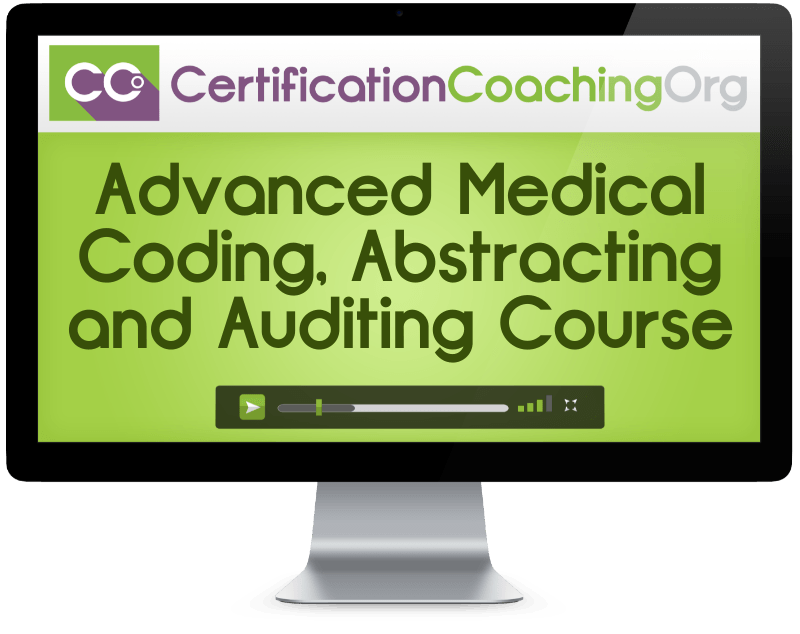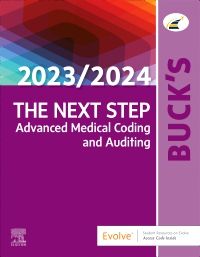Advanced Medical Coding, Abstracting and Auditing Course
An Advanced Course That Will Deepen Your Knowledge of Medical Coding, Abstracting and Auditing Through Engaging Video Case Studies
Help master your advanced medical coding skills! In our Advanced Medical Coding, Abstracting and Auditing Course. CCO will show how to code for services such as medical visits, diagnostic testing and interpretation, treatments, surgeries, and anesthesia through engaging video lessons.
Within the textbook, real-world cases (cleared of any patient identifiers) take your coding proficiency a step further by providing hands-on practice with physician documentation. With the textbook and our videos, you will learn to pull the right information from medical documents, select the right codes, determine the correct sequencing of those codes, and properly audit cases.
In addition to the core Advanced Medical Coding training materials, we also provide access to certified CCO instructors to help answer any questions that may come up.
Who Can Benefit From This Advanced Medical Coding, Abstracting and Auditing Course:
- Existing students enrolled inside or outside CCO that require supplemental or expanded training in Medical Coding or wish to see how we dissect real-world medical coding cases on video.
- Administrative Healthcare workers interested in expanding their knowledge of Medical Coding and Auditing.
- Important Pre-Requisite: Students should have a solid foundation of Medical Coding, Medical Terminology and Anatomy and ICD-10-CM knowledge. In addition, you should have recently passed a medical coding course, possessing a clinical or medical coding experience, or holding a relevant coding credential such as the CPC® or CPC-A® to properly learn the material.

Watch Us Walk You Through Real-World Patient Cases
Improve Your Existing Medical Coding, Auditing and Abstracting Skills
This course requires the separate purchase of this textbook. Students should already own the 2023 CPT® and ICD-10-CM Manuals which are also required.
This AMCAA Course does not prepare you for the CPC®, CIC®, COC®, CPMA® or other credendials.

Includes The BHAT® System
BHAT® (pronounced ‘bat’) stands for “Bubble, Highlight and Annotate Technique“. This is a proprietary system, which is used in connection with our educational services, created by Laureen Jandroep in 1999 that uses bubbling, highlighting and annotation techniques to help students quickly find key answers in their manuals during the open book CPC® exams.
Instead of flipping back and forth between pages where the guidelines are, the answers are right next to the codes when a student takes the board exam. Students have stated the BHAT® system gave them the confidence they needed to pass the exam. Another plus: the BHAT® system also helps coders in their day to day coding work! [Learn More]
Whats’s Included In Our Advanced Medical Coding Course
14+ Hours of Real-World Video Case Studies
Alicia will walk you through 14 hours of common, patient case studies that you may experience in the real world. Along the way, she imparts her wisdom, reasoning and education on the best way to code them.
67 Sample Patient Case Studies with Questions & Answers
We include 67 sample patient case studies across all common areas to self-test and ensure you’re familiar with reviewing, abstracting and coding sample patient cases.
27 Auditing Case Studies with Questions & Answers
We include 27 auditing case studies to self-test and ensure you’ve learned how to properly audit medical coding cases before moving on.
Easy to Understand Style
We know it can be hard to learn coding material. That’s why we pride ourselves on our “easy to understand” teaching style. Keeping you engaged and learning is our top priority.
Self-Paced, Online Courses
All our courses are available 24 hours a day, 7 days a week from any internet-enabled device. You can learn at your own pace and rewind whenever necessary to re-learn topics.
9 Months of Continuous Access
We include 9 months (270 days) of continuous access to the course. If you decide to take a break, you can always return anytime within those 9 months to pick up where you left off.
Live Group Calls
Our instructors meet with many students on a live “group call” via video conferencing to answer all course and career questions. As a full course student you’re invited to call in and ask questions during the live call.
Certified Instructor Support
Our certified CCO Instructor will first get to know you during your welcome call. During your study, they will also provide ongoing encouragement, guidance and direction via private, forum-based coaching.
Student Support Hub
Our Student Support Hub is where students, staff and instructors can meet virtually inside a private discussion area to ask questions or simply chat about course topics and news.
AMCAA Course Contents
The most often reported codes in the CPT manual are those in the Evaluation and Management (E/M) section. These codes can also be the most troublesome for the new coder to assign because there are so many variables; but once we teach you all the intricacies of E/M coding, you will be able to assign codes with complete confidence that you have selected the correct code.
We will present video case studies related to Evaluation and Management to help students master this specialty.
The Medicine section has many subsections that encompass a broad range of services. We will review these subsections in the CPT® and then review the Medicine Guidelines. The section contains diagnostic (determining nature of disease) and therapeutic (curative) services that are both invasive (entering the body) and noninvasive (not entering the body).
We will present video case studies related to the Medicine section to help students master this topic.
Radiology is the branch of medicine that uses radiant energy to diagnose and treat patients. The term originally referred to the use of x-rays to produce radiographs but is now commonly applied to all tvpes of medical imaging. A physician who specializes in radiology is a radiologist. Radiologists can provide services to patients independent of or in conjunction with another physician of a different specialty. The Radiology section of the CPT manual is divided into the main subsections of Diagnostic
Radiology, Diagnostic Utrasound, Radiation Oncology, and Nuclear Medicine.
We will present video case studies related to Radiology to help students sharpen their coding within this specialty.
The codes in the Pathology and Laboratory section of the CPT manual cover a wide variety of services. The following are the types of services most commonly used:
- Organ- or Disease-Oriented Panels (80047-80081)
- Therapeutic Drug Assays (80150-80299)
- Urinalysis (81000-81099)
- Chemistry (82009-84999)
- Hematology and Coagulation (85002-85999)
- Immunology (86000-86849)
We will present video case studies related to Pathology and Laboratory to help students deepen their knowledge of coding within these subjects.
The codes in the Integumentary section of the CPT manual cover a wide variety of services. The following are the types of services most commonly used:
- Debridement
- Skin Biopsy and Skin Tags
- Lesion Excision
- Nails
- Repairs (Closure)
- Adjacent Tissue Transfers or Rearrangements
- Skin Grafts
- Pressure Ulcers
- Breast Procedures
We will present video case studies related to the Integumentary system to help students deepen their knowledge of coding within these services.
A cardiologist is a physician who specializes in diseases of the heart and vessels. A cardiothoracic surgeon is a physician who specializes in surgical procedures of the heart and chest. A variety of physicians frequently use the codes, as you will see as you code the services and procedures within this chapter. Examples of procedures include valve repair, beating heart surgery, aortic dissections, and excision of tumors of the chest wall.
When coding cardiovascular services, the coder will commonly use codes from the Evaluation/Management, Surgery, Medicine, and Radiology sections of the CPT manual.
The more common cardiovascular presenting problems are chest pain, hypertension, edema, murmur, mitral valve prolapse, palpitations, congestive heart failure, acute ischemia, abnormal stress tests, arrhythmias, congenital heart disease, syncope (fainting), hyperlipidemia, and claudication.
We will present video case studies related to the Cardiovascular system to help students sharpen their knowledge of coding within this area.
The codes in the Digestive System, Hemic/Lymphatic System section of the CPT manual cover a wide variety of services. The following are the types of services most commonly used:
- E/M Services
- External Procedures
- Endoscopies
- Rectal Procedures
- Laparoscopic Procedures
- Incisional Surgical Procedures
We will present video case studies related to the Digestive System, Hemic/Lymphatic system to help students sharpen their knowledge of coding within these systems.
Common musculoskeletal complaints are pain of the neck, knee, shoulder, elbow, wrist, hand, back, hip, ankle, and foot. Conditions commonly related to the musculoskeletal system are sprains, bursitis, tendonitis, dislocations, fractures, nerve entrapments (such as carpal tunnel syndrome), and gout.
We will present video case studies related to the Musculoskeletal system to help students deepen their knowledge of coding within these services.
The respiratory system often reflects diseases in other organ systems of the body. The process of respiration includes not only the lungs but also the diaphragm, the brain (regulates respiration through cerebral regulatory centers), and the cardiovascular system. The physician treating the patient with pulmonary disease must take into consideration a wide variety of pathological considerations. For example, areas of density on a chest x-ray may be caused by pulmonary infection or tumor. Dysfunction of the lungs could represent a systemic disease, such as an embolism or a cardiac disturbance. The physician will begin the diagnostic process with a complete history and physical.
We will present video case studies related to the Respiratory system to help students improve their ability to code these services.
Common urinary symptoms are nocturia, polyuria, hematuria, proteinuria, dysuria, oliguria, urinary incontinence, and enuresis. Often treated urinary conditions include hypercalciuria (urinary stones caused by the body’s inability to process calcium properly), renal failure, pyelonephritis, and infections as well as kidney and bladder cancer.
We will present video case studies related to the Urinary, Male Genital, and Endocrine systems to help students improve their ability to code these services.
Common reproductive presenting complaints are dysmenorrhea (painful menstruation), abnormal vaginal bleeding, abnormal Pap smears, nipple discharge, vaginal discharge, and pelvic pain. Conditions often treated are fibrocystic breast disease, female genital system cancer, vaginitis, cervicitis, sexually transmitted diseases, endometriosis, menopause, premenstrual syndrome, infertility, and pregnancy. Frequently performed office procedures include Pap smear, colposcopy, and cervical biopsy, as well as implantation of contraceptives such as an intrauterine device, Norplant, and diaphragms.
We will present video case studies related to Female Genital System and Maternity Care/Delivery to help students improve their knowledge of coding these procedures.
The nervous system is divided into the sympathetic nervous system and the parasympathetic nervous system. A neurologist is a physician who treats and diagnoses conditions of the nervous system, including the spinal cord, brain, nerves, and muscles. Common neurologic disorders are dizziness, tremor, paresthesia (abnormal touch sensation), stroke, altered mental states, headache, seizure, sleep disorders, and neuralgia. The neurologist uses a variety of diagnostic tools, including magnetic resonance imaging (MRI), computed axial tomography (CAT or CT), electroencephalography (EEG), and EMG/NCV (electromyography/nerve conduction velocity). A neurosurgeon is a surgeon who specializes in surgical procedures or treatment of conditions of the nervous system, such as lumbar puncture, brain tumor, head injury, hematoma, and disc herniation.
We will present video case studies related to the Nervous System to help students master their knowledge of coding this system.
An ophthalmologist is a physician who specializes in medical and surgical care of the eye and visual system. The ophthalmologist provides a full spectrum of care, including the diagnosis and medical treatment of eye disorders and diseases, prescription of eyeglasses, routine eye exams, a variety of eye and visual system surgery, and management of eye problems that are caused by systemic illnesses, such as diabetic retinopathy. Ophthalmologists can be doctors of osteopathy (DO) or medical doctors (MD). Optometrists and opticians perform eye examinations, but they are not physicians and cannot perform surgery.
Common conditions diagnosed and treated by an ophthalmologist are conjunctivitis, corneal ulceration, corneal foreign body removal, optic neuritis, retinopathy, refractive error correction, macular degeneration, glaucoma, cataracts, and blepharitis.
We will present video case studies related to the Eye and Auditory Systems to help students master their knowledge of coding these systems.
This chapter will provide an overview of the types of anesthesia services and some important factors to consider when reporting anesthesia services. You will learn about the role of the anesthesia professional in providing anesthesia care, pain management, and critical care to patients. Moderate (conscious) sedation and patient-controlled analgesia will be reported.
We will present video case studies related to Anesthesia to help students master their knowledge of coding this service.
Meet Your AMCAA Course Instructor
Alicia Scott, CPC, CPC-I, CRC
CCO Education Director
Alicia has been working in the medical field for over 20 years. She first learned about medical coding while working in a medical records department at a resort town hospital near where she was raised. Through the years she has held several jobs in the medical field from, CNA, EMT, Pharmacy technician and Medical Records Abstractor and Analyst. Outside of the medical field she has worked as a Real Estate agent, and owned her own on-line retail business. The medical field has always been where she felt the most comfortable.
Alicia has taught medical coding, billing and medical law and ethics at a private college. She also did contract work in HCC Risk Adjustment and discovered she really enjoyed ICD work. Because she loves to learn Alicia is working towards her Masters in Health Care Administration with an emphasis on education. Having taken many online classes through the years to complete her degree she feels very comfortable with both face to face and on-line learning. Alicia will tell you that not only does she love medical coding but she has a passion for teaching it. Alicia lives in the middle of Texas with her husband who is a Pastor, five of her six children, three dogs and two cats.

Invest In Your Future Today!
Yes! Please I’d Like to Order The Advanced Medical Coding, Abstracting and Auditing Course
I understand I’ll be receiving online access to the entire Advanced Medical Coding, Abstracting and Auditing Course plus access to the BHAT® Cave and other CCO resources listed on this page for a small investment!

Frequently Asked Questions
Is a Textbook Needed for The AMCAA Course?
Yes. This course requires the separate purchase of the Buck’s The Next Step: Advanced Medical Coding and Auditing, 2023/2024 Edition, 1st Edition textbook. Students should already own the 2023 CPT® and ICD-10-CM Manuals.
Are There Any CEUs Included?
No, there are no CEUs included with this course. If you need CEU’s, please consider joining the CCO Club. https://www.cco.us/club/
Are There Any Graded Exams?
No, this Advanced Medical Coding, Abstracting and Auditing Course does not include any graded exams. Students are given access to cases and their respective answers for self-paced learning along with a community area to discuss any challenges they may encounter.
Can I Download or Play the Videos Offline?
Videos can only be played while connected to a high-speed internet connection. We do not allow videos to be downloaded or played offline.
When Will the AMCAA Course Be Available for Viewing?
The course is schedule to begin recording on May 8th. As lessons are completed, replay videos and slides will be added to the Student Area for replay and review. Transcriptions will be added later as they’re completed.
Do I Need to Be a Certified Coder to Take This Course?
Yes, or your need some coding experience! Due to the advanced .material included in this course, there is no “learn from scratch” teaching included. We walk through patient cases and its expected you already know how to code from a job or by passing a recent certification.
What Is the Refund or Cancellation Policy?
Due to the instant availability of internet-based training, CCO does not provide refunds or cancellations on any of our products including Courses, Review Blitzes, Practice Exams, Bundles, CEU Classes, Combos or CCO Club payments.
Where Can I Learn More About CCO?
Since 1999, we’ve been proudly training thousands of students to help them pass their certification exams. If you feel the need to see examples of our teaching style, please visit our YouTube channel with hundreds of videos and over 2 million views. If you would like to read past student reviews on our products, you’re welcome to read through hundreds of testimonials.
![[CCO] Certification Coaching Organization LLC [CCO] Certification Coaching Organization LLC](https://www.cco.us/wp-content/uploads/2015/05/CCO-Logo-2015-d3-500px.png)
